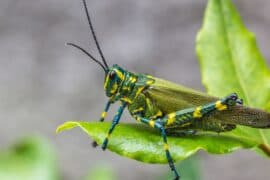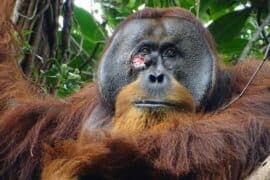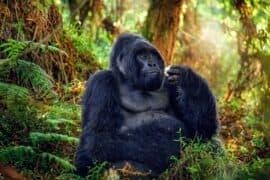L'Hoest's monkey
(Allochrocebus lhoesti)
Description
L'Hoest's monkey (Allochrocebus lhoesti) or mountain monkey, is a guenon found in the upper eastern Congo basin. They mostly live in mountainous forest areas in small, female-dominated groups. They have a dark coat and can be distinguished by a characteristic white beard. It was Philip Lutley Sclater who originally gave the specific name Cercopithecus lhoesti in honor of Michel L'Hoest, director of the Antwerp Zoo, in 1898. L'Hoest's monkey is currently classified as a member of the genus Allochrocebus. Formerly, L'Hoest's monkey included the taxon preussi from the Gulf of Guinea region as a subspecies, but it is now considered a separate species, Preuss's monkey (A. preussi). L'Hoest's monkey was formerly included in the genus Cercopithecus. Molecular studies published by Anthony Tosi in 2003 had raised doubts about the classification of L'Hoest's monkey as a member of the genus Cercopithecus. The studies indicated that L'Hoest's monkey (along with the others in its species group) is more closely related to the vervet monkeys of the genus Chlorocebus and the patas monkey (genus Erythrocebus) than to the other guenons of the genus Cercopithecus. C. lhoesti has a short, dark brown coat, with a chestnut color across the back and a dark belly. Its cheeks are light gray with a pale moustache. It has a characteristic and prominent white bib, In body length it is 12.5 to 27 inches (32 to 69 cm), with a 19-to-39-inch (48 to 99 cm) tail. The male weighs about 6 kilograms (13 lb), while the smaller female weighs 3.5 kilograms (7.7 lb). Its tail is long and hook-shaped at the end. They are born fully coated and with their eyes open. L'Hoest's monkey occurs in northeastern Democratic Republic of the Congo, Rwanda, Burundi, and western Uganda. It is a forest monkey, which is typical of the moist and high primary forests. It will occupy a range of different kinds of forested areas, including gallery forest, mature lowland rain forests, wooded savanna at mountain slopes, and forest borders. However, it also will live on cultivated lands. In lowland forests it shows a preference toward areas where the forest is regenerating, while in mountain areas it will frequent the mature, tangled, undergrowth below the broken canopy. One study found this population only above 900 metres (3,000 ft) but another found it as low as 610 metres (2,000 ft). Another mostly observed it from 1,500 to 2,500 metres (4,900 to 8,200 ft).
Taxonomic tree:







